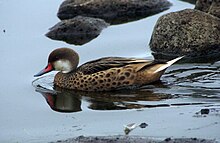White-cheeked pintail
| White-cheeked pintail | |
|---|---|

| |
| Anas bahamensis galapagensis | |
| Scientific classification | |
| Domain: | Eukaryota |
| Kingdom: | Animalia |
| Phylum: | Chordata |
| Class: | Aves |
| Order: | Anseriformes |
| Family: | Anatidae |
| Genus: | Anas |
| Species: | A. bahamensis
|
| Binomial name | |
| Anas bahamensis | |
| Subspecies | |
The white-cheeked pintail (Anas bahamensis), also known as the Bahama pintail or summer duck,[2] is a species of dabbling duck. It was first described by Carl Linnaeus in his landmark 1758 10th edition of Systema Naturae under its current scientific name.[3]
Distribution and habitat
It is found in the Caribbean, South America, and the Galápagos Islands.[4] It occurs on waters with some salinity, such as brackish lakes, estuaries and mangrove swamps.[4] There are three subspecies:
- A. b. bahamensis—lesser Bahama pintail[2]—in the Caribbean, and a vagrant to southern Florida
- A. b. rubirostris—greater Bahama pintail[2]—in South America; it may be partly migratory, breeding in Argentina and wintering further north.[4]
- A. b. galapagensis—Galapagos pintail[2]—in the Galapagos
Description
Like many southern ducks, the sexes are similar. It is mainly brown with white cheeks and a red-based grey bill (young birds lack the pink). It cannot be confused with any other duck in its range.[4]
Behaviour
The white-cheeked pintail feeds on aquatic plants and small creatures obtained by dabbling. The nest is on the ground under vegetation and near water.[4]
Aviculture
It is popular in wildfowl collections, and escapees are frequently seen in a semi-wild condition in Europe. A leucistic (whitish) variant is known in aviculture as the silver Bahama pintail.[2]
Gallery
-
Adult on left with red at the base of its beak and a juvenile with an all black bill on the right
-
Whitish variant
-
Two white-cheeked pintails on the Island of Santa Cruz in the Galápagos Islands
-
Taken in the Galápagos Islands
References
- ^ BirdLife International (2012). "Anas bahamensis". IUCN Red List of Threatened Species. 2012. Retrieved 26 November 2013.
{{cite journal}}: Invalid|ref=harv(help) - ^ a b c d e Cowell, Dan. "Bahama Pintail / White-cheeked Pintail". Harteman Wildfowl. Jan Harteman. Retrieved 2012-04-29.
- ^ Linnaeus, Carl (1758). Systema naturae per regna tria naturae, secundum classes, ordines, genera, species, cum characteribus, differentiis, synonymis, locis. Tomus I. Editio decima, reformata (in Latin). Holmiae. (Laurentii Salvii). p. 124.
A. grisea, rostro plumbeo: macula laterali fulva, macula alarum viridi luteaque.
- ^ a b c d e Madge, Steve; Burn, Hilary (1988). Wildfowl: An Identification Guide to the Ducks, Geese and Swans of the World (Helm Identification Guides). Christopher Helm. pp. 224–225. ISBN 0-7470-2201-1.
External links
- White-cheeked pintail videos, photos, and sounds on the Internet Bird Collection








